Resistance of Grassland under Different Drought Types in the Inner Mongolia Autonomous Region of China
Abstract
:1. Introduction
2. Materials and Methods
2.1. Study Area
2.2. SPEI Data
2.3. NPP Data
2.4. Calculation Method of Grassland Drought Resistance
2.5. Research Framework
3. Results
3.1. Spatiotemporal Characteristics of Different Droughts from 1982 to 2018
3.2. Spatial Distribution Characteristics of Resistance under Different Drought Types
3.2.1. Resistance under Moderate Drought
3.2.2. Resistance under Severe Drought
3.2.3. Resistance under Extreme Drought
3.3. Resistance Characteristics in Different Grassland Types under Different Droughts
4. Discussion
4.1. Characteristics of Drought Occurrence
4.2. Characteristics of Resistance in Different Grassland Types
4.3. Factors Influencing Resistance under Drought
5. Conclusions
Author Contributions
Funding
Data Availability Statement
Acknowledgments
Conflicts of Interest
References
- Cook, B.I.; Mankin, J.S.; Anchukaitis, K.J. Climate Change and Drought: From Past to Future. Curr. Clim. Chang. Rep. 2018, 4, 164–179. [Google Scholar] [CrossRef]
- Zhao, M.; Running, S.W. Drought-induced reduction in global terrestrial net primary production from 2000 through 2009. Science 2010, 329, 940–943. [Google Scholar] [CrossRef] [PubMed]
- Kelley, C.P.; Mohtadi, S.; Cane, M.A.; Seager, R.; Kushnir, Y. Climate change in the Fertile Crescent and implications of the recent Syrian drought. Proc. Natl. Acad. Sci. USA 2015, 112, 3241–3246. [Google Scholar] [CrossRef]
- Vicente-Serrano, S.M.; Gouveia, C.; Camarero, J.J.; Begueria, S.; Trigo, R.; Lopez-Moreno, J.I.; Azorin-Molina, C.; Pasho, E.; Lorenzo-Lacruz, J.; Revuelto, J.; et al. Response of vegetation to drought time-scales across global land biomes. Proc. Natl. Acad. Sci. USA 2013, 110, 52–57. [Google Scholar] [CrossRef]
- Beloiu, M.; Stahlmann, R.; Beierkuhnlein, C. Drought impacts in forest canopy and deciduous tree saplings in Central European forests. For. Ecol. Manag. 2022, 509, 120075. [Google Scholar] [CrossRef]
- Hossain, M.L.; Li, J. Biomass partitioning of C3- and C4-dominated grasslands in response to climatic variability and climate extremes. Environ. Res. Lett. 2021, 16, 074016. [Google Scholar] [CrossRef]
- Torreño, A.A.; Barrena-González, J.; Lozano-Parra, J.; Garrido-Velarde, J. Assessment of Bare Soil in Extensive Livestock Areas in the Southwest of the Iberian Peninsula by Multi-Temporal Orthophotographs (2002–2016). In Handbook of Research on Current Advances and Challenges of Borderlands, Migration, and Geopolitics; IGI Global: Hershey, PA, USA, 2023; pp. 179–193. [Google Scholar]
- Seager, R.; Ting, M.; Li, C.; Naik, N.; Cook, B.; Nakamura, J.; Liu, H. Projections of declining surface-water availability for the southwestern United States. Nat. Clim. Chang. 2012, 3, 482–486. [Google Scholar] [CrossRef]
- Chen, J.; Dong, G.; Chen, J.; Jiang, S.; Qu, L.; Legesse, T.G.; Zhao, F.; Tong, Q.; Shao, C.; Han, X. Energy balance and partitioning over grasslands on the Mongolian Plateau. Ecol. Indic. 2022, 135, 108560. [Google Scholar] [CrossRef]
- Doležal, J.; Altman, J.; Jandová, V.; Chytrý, M.; Conti, L.; Méndez-Castro, F.E.; Klimešová, J.; Zelený, D.; Ottaviani, G. Climate warming and extended droughts drive establishment and growth dynamics in temperate grassland plants. Agric. For. Meteorol. 2022, 313, 108762. [Google Scholar] [CrossRef]
- Liu, H.; Lin, L.; Wang, H.; Zhang, Z.; Shangguan, Z.; Feng, X.; He, J.-S. Simulating warmer and drier climate increases root production but decreases root decomposition in an alpine grassland on the Tibetan plateau. Plant Soil 2020, 458, 59–73. [Google Scholar] [CrossRef]
- Lei, T.; Wu, J.; Li, X.; Geng, G.; Shao, C.; Zhou, H.; Wang, Q.; Liu, L. A new framework for evaluating the impacts of drought on net primary productivity of grassland. Sci. Total Environ. 2015, 536, 161–172. [Google Scholar] [CrossRef]
- Luo, W.; Zuo, X.; Griffin-Nolan, R.J.; Xu, C.; Ma, W.; Song, L.; Helsen, K.; Lin, Y.; Cai, J.; Yu, Q.; et al. Long term experimental drought alters community plant trait variation, not trait means, across three semiarid grasslands. Plant Soil 2019, 442, 343–353. [Google Scholar] [CrossRef]
- Xu, C.; Ke, Y.; Zhou, W.; Luo, W.; Ma, W.; Song, L.; Smith, M.D.; Hoover, D.L.; Wilcox, K.R.; Fu, W.; et al. Resistance and resilience of a semi-arid grassland to multi-year extreme drought. Ecol. Indic. 2021, 131, 108139. [Google Scholar] [CrossRef]
- Carroll, C.J.W.; Slette, I.J.; Griffin-Nolan, R.J.; Baur, L.E.; Hoffman, A.M.; Denton, E.M.; Gray, J.E.; Post, A.K.; Johnston, M.K.; Yu, Q.; et al. Is a drought a drought in grasslands? Productivity responses to different types of drought. Oecologia 2021, 197, 1017–1026. [Google Scholar] [CrossRef] [PubMed]
- Lei, T.; Feng, J.; Lv, J.; Wang, J.; Song, H.; Song, W.; Gao, X. Net Primary Productivity Loss under different drought levels in different grassland ecosystems. J. Environ. Manag. 2020, 274, 111144. [Google Scholar] [CrossRef] [PubMed]
- Isbell, F.; Craven, D.; Connolly, J.; Loreau, M.; Schmid, B.; Beierkuhnlein, C.; Bezemer, T.M.; Bonin, C.; Bruelheide, H.; de Luca, E.; et al. Biodiversity increases the resistance of ecosystem productivity to climate extremes. Nature 2015, 526, 574–577. [Google Scholar] [CrossRef] [PubMed]
- Li, L.; Zheng, Z.; Biederman, J.A.; Qian, R.; Ran, Q.; Zhang, B.; Xu, C.; Wang, F.; Zhou, S.; Che, R.; et al. Drought and heat wave impacts on grassland carbon cycling across hierarchical levels. Plant Cell Environ. 2021, 44, 2402–2413. [Google Scholar] [CrossRef]
- Pimm, S.L. The complexity and stability of ecosystems. Nature 1984, 307, 321–326. [Google Scholar] [CrossRef]
- Hossain, M.L.; Kabir, M.H.; Nila, M.U.S.; Rubaiyat, A. Response of grassland net primary productivity to dry and wet climatic events in four grassland types in Inner Mongolia. Plant Environ. Interact. 2021, 2, 250–262. [Google Scholar] [CrossRef]
- Cui, A.; Li, J.; Zhou, Q.; Zhu, R.; Liu, H.; Wu, G.; Li, Q. Use of a multiscalar GRACE-based standardized terrestrial water storage index for assessing global hydrological droughts. J. Hydrol. 2021, 603, 126871. [Google Scholar] [CrossRef]
- Liu, Y.; Zhu, Y.; Ren, L.; Singh, V.P.; Yang, X.; Yuan, F. A multiscalar Palmer drought severity index. Geophys. Res. Lett. 2017, 44, 6850–6858. [Google Scholar] [CrossRef]
- Vicente-Serrano, S.M.; Beguería, S.; López-Moreno, J.I.; Angulo, M.; El Kenawy, A. A New Global 0.5° Gridded Dataset (1901–2006) of a Multiscalar Drought Index: Comparison with Current Drought Index Datasets Based on the Palmer Drought Severity Index. J. Hydrometeorol. 2010, 11, 1033–1043. [Google Scholar] [CrossRef]
- Begueria, S.; Vicente-Serrano, S.M.; Reig, F.; Latorre, B. Standardized precipitation evapotranspiration index (SPEI) revisited: Parameter fitting, evapotranspiration models, tools, datasets and drought monitoring. Int. J. Climatol. 2014, 34, 3001–3023. [Google Scholar] [CrossRef]
- Anderegg, W.R.L.; Trugman, A.T.; Badgley, G.; Konings, A.G.; Shaw, J. Divergent forest sensitivity to repeated extreme droughts. Nat. Clim. Chang. 2020, 10, 1091–1119. [Google Scholar] [CrossRef]
- Deng, Y.; Wu, D.; Wang, X.; Xie, Z. Responding time scales of vegetation production to extreme droughts over China. Ecol. Indic. 2022, 136, 108630. [Google Scholar] [CrossRef]
- Deng, L.; Shangguan, Z.-P.; Wu, G.-L.; Chang, X.-F. Effects of grazing exclusion on carbon sequestration in China’s grassland. Earth-Sci. Rev. 2017, 173, 84–95. [Google Scholar] [CrossRef]
- Wang, S.; Tuya, H.; Zhang, S.; Zhao, X.; Liu, Z.; Li, R.; Lin, X. Random forest method for analysis of remote sensing inversion of aboveground biomass and grazing intensity of grasslands in Inner Mongolia, China. Int. J. Remote Sens. 2023, 44, 2867–2884. [Google Scholar] [CrossRef]
- National Forestry and Grassland Administration. In China, 40% of the Land Is Grassland. Available online: http://www.forestry.gov.cn/main/5462/20210311/115701724435306.html (accessed on 1 September 2023).
- Wang, X.; Luo, P.; Zheng, Y.; Duan, W.; Wang, S.; Zhu, W.; Zhang, Y.; Nover, D. Drought Disasters in China from 1991 to 2018: Analysis of Spatiotemporal Trends and Characteristics. Remote Sens. 2023, 15, 1708. [Google Scholar] [CrossRef]
- Wang, Y.; Liu, G.; Guo, E. Spatial distribution and temporal variation of drought in Inner Mongolia during 1901–2014 using Standardized Precipitation Evapotranspiration Index. Sci. Total Environ. 2019, 654, 850–862. [Google Scholar] [CrossRef]
- Huang, K.; Xia, J. High ecosystem stability of evergreen broadleaf forests under severe droughts. Glob. Chang. Biol. 2019, 25, 3494–3503. [Google Scholar] [CrossRef]
- Vicente-Serrano, S.M.; Beguería, S.; López-Moreno, J.I. A Multiscalar Drought Index Sensitive to Global Warming: The Standardized Precipitation Evapotranspiration Index. J. Clim. 2010, 23, 1696–1718. [Google Scholar] [CrossRef]
- Dorman, M.; Svoray, T.; Perevolotsky, A.; Sarris, D. Forest performance during two consecutive drought periods: Diverging long-term trends and short-term responses along a climatic gradient. For. Ecol. Manag. 2013, 310, 1–9. [Google Scholar] [CrossRef]
- Xu, P.; Fang, W.; Zhou, T.; Li, H.; Zhao, X.; Berman, S.; Zhang, T.; Yi, C. Satellite evidence of canopy-height dependence of forest drought resistance in southwestern China. Environ. Res. Lett. 2022, 17, 025005. [Google Scholar] [CrossRef]
- IPCC. Climate Change 2021; Cambridge University Press: Cambridge, UK, 2021. [Google Scholar]
- An, Q.; He, H.; Nie, Q.; Cui, Y.; Gao, J.; Wei, C.; Xie, X.; You, J. Spatial and Temporal Variations of Drought in Inner Mongolia, China. Water 2020, 12, 1715. [Google Scholar] [CrossRef]
- Liang, M.; Cao, R.; Di, K.; Han, D.; Hu, Z. Vegetation resistance and resilience to a decade-long dry period in the temperate grasslands in China. Ecol. Evol. 2021, 11, 10582–10589. [Google Scholar] [CrossRef]
- Miao, Y.; Zhou, Z.; Jiang, M.; Song, H.; Yan, X.; Liu, P.; Ji, M.; Han, S.; Chen, A.; Wang, D. Resistance and Resilience of Nine Plant Species to Drought in Inner Mongolia Temperate Grasslands of Northern China. Appl. Sci. 2022, 12, 4967. [Google Scholar] [CrossRef]
- Hossain, M.L.; Li, J. NDVI-based vegetation dynamics and its resistance and resilience to different intensities of climatic events. Glob. Ecol. Conserv. 2021, 30, e01768. [Google Scholar] [CrossRef]
- Ma, W.; Liang, X.; Wang, Z.; Luo, W.; Yu, Q.; Han, X. Resistance of steppe communities to extreme drought in northeast China. Plant Soil 2022, 473, 181–194. [Google Scholar] [CrossRef]
- Zhang, L.H.; Wang, J.F.; Zhao, R.F.; Guo, Y.F.; Hao, L.Y.; Hu, Z.M. Aboveground net primary productivity and soil respiration display different responses to precipitation changes in desert grassland. J. Plant Ecol. 2022, 15, 57–70. [Google Scholar] [CrossRef]
- Mackie, K.A.; Zeiter, M.; Bloor, J.M.G.; Stampfli, A. Plant functional groups mediate drought resistance and recovery in a multisite grassland experiment. J. Ecol. 2019, 107, 937–949. [Google Scholar] [CrossRef]
- Cleland, E.E.; Chiariello, N.R.; Loarie, S.R.; Mooney, H.A.; Field, C.B. Diverse responses of phenology to global changes in a grassland ecosystem. Proc. Natl. Acad. Sci. USA 2006, 103, 13740–13744. [Google Scholar] [CrossRef] [PubMed]
- Guo, J.W.; Zhao, C.C.; Zhang, L.N.; Han, Y.Y.; Cao, R.; Liu, Y.Z.; Sun, S.C. Water table decline alters arthropod community structure by shifting plant communities and leaf nutrients in a Tibetan peatland. Sci. Total. Environ. 2022, 814, 151944. [Google Scholar] [CrossRef] [PubMed]
- Stuart-Haentjens, E.; De Boeck, H.J.; Lemoine, N.P.; Mand, P.; Kroel-Dulay, G.; Schmidt, I.K.; Jentsch, A.; Stampfli, A.; Anderegg, W.R.L.; Bahn, M.; et al. Mean annual precipitation predicts primary production resistance and resilience to extreme drought. Sci. Total Environ. 2018, 636, 360–366. [Google Scholar] [CrossRef]
- Zhong, M.X.; Song, J.; Zhou, Z.X.; Ru, J.Y.; Zheng, M.M.; Li, Y.; Hui, D.F.; Wan, S.Q. Asymmetric responses of plant community structure and composition to precipitation variabilities in a semi-arid steppe. Oecologia 2019, 191, 697–708. [Google Scholar] [CrossRef] [PubMed]
- Knapp, A.K.; Carroll, C.J.; Denton, E.M.; La Pierre, K.J.; Collins, S.L.; Smith, M.D. Differential sensitivity to regional-scale drought in six central US grasslands. Oecologia 2015, 177, 949–957. [Google Scholar] [CrossRef]
- Vandegeer, R.K.; Tissue, D.T.; Hartley, S.E.; Glauser, G.; Johnson, S.N. Physiological acclimation of a grass species occurs during sustained but not repeated drought events. Environ. Exp. Bot. 2020, 171, 103954. [Google Scholar] [CrossRef]
- Tielborger, K.; Bilton, M.C.; Metz, J.; Kigel, J.; Holzapfel, C.; Lebrija-Trejos, E.; Konsens, I.; Parag, H.A.; Sternberg, M. Middle-Eastern plant communities tolerate 9 years of drought in a multi-site climate manipulation experiment. Nat. Commun. 2014, 5, 5102. [Google Scholar] [CrossRef]

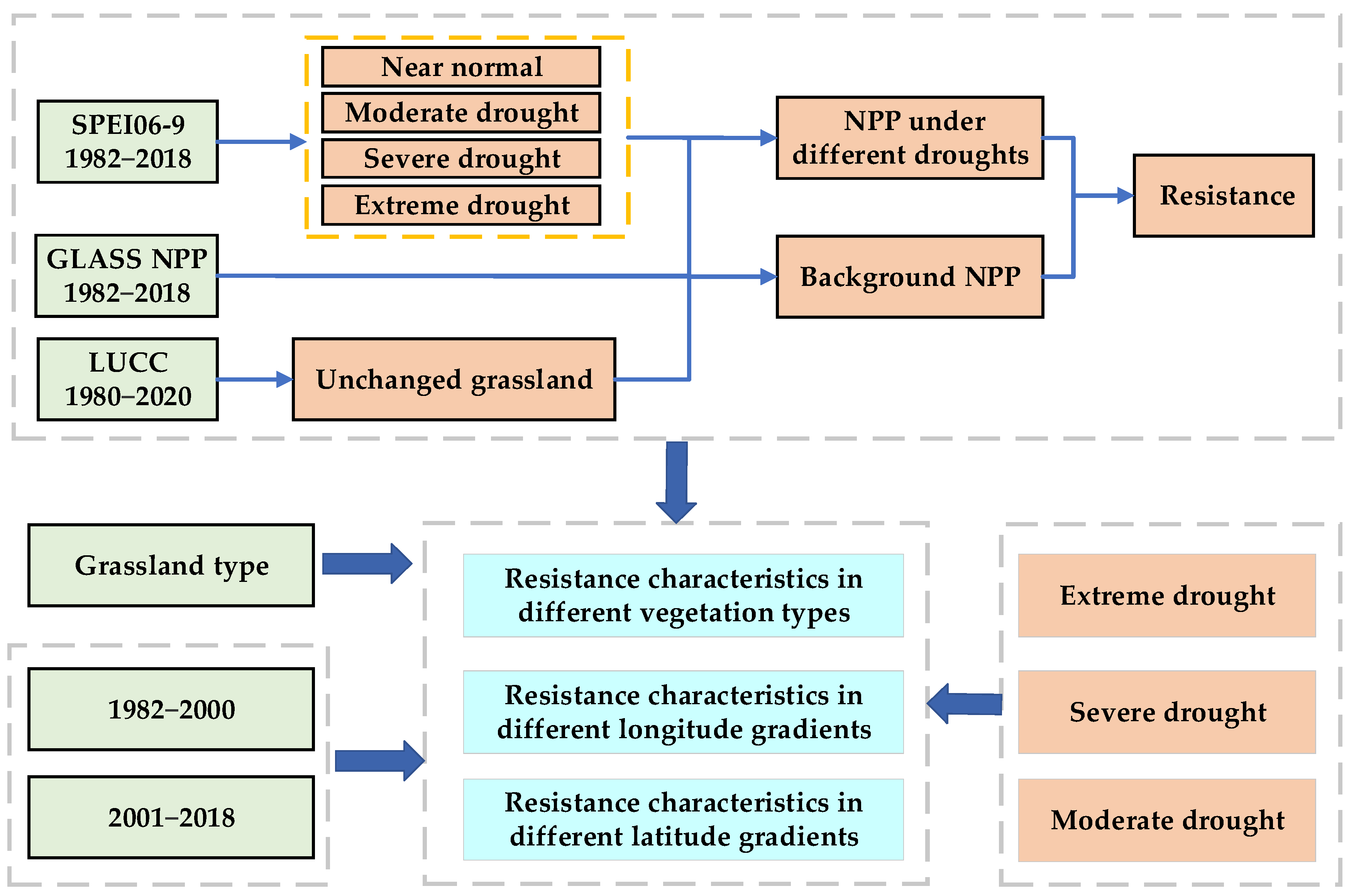


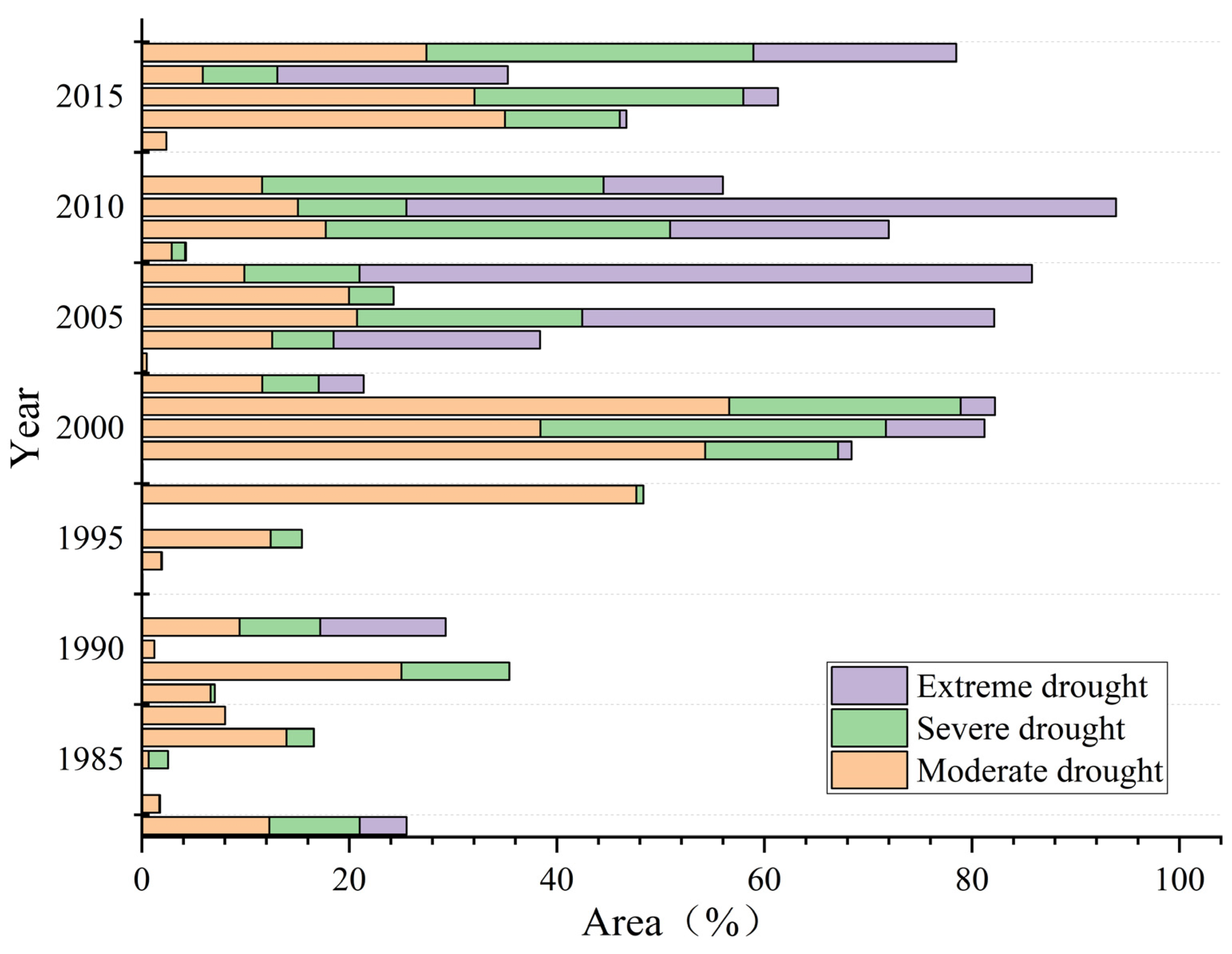
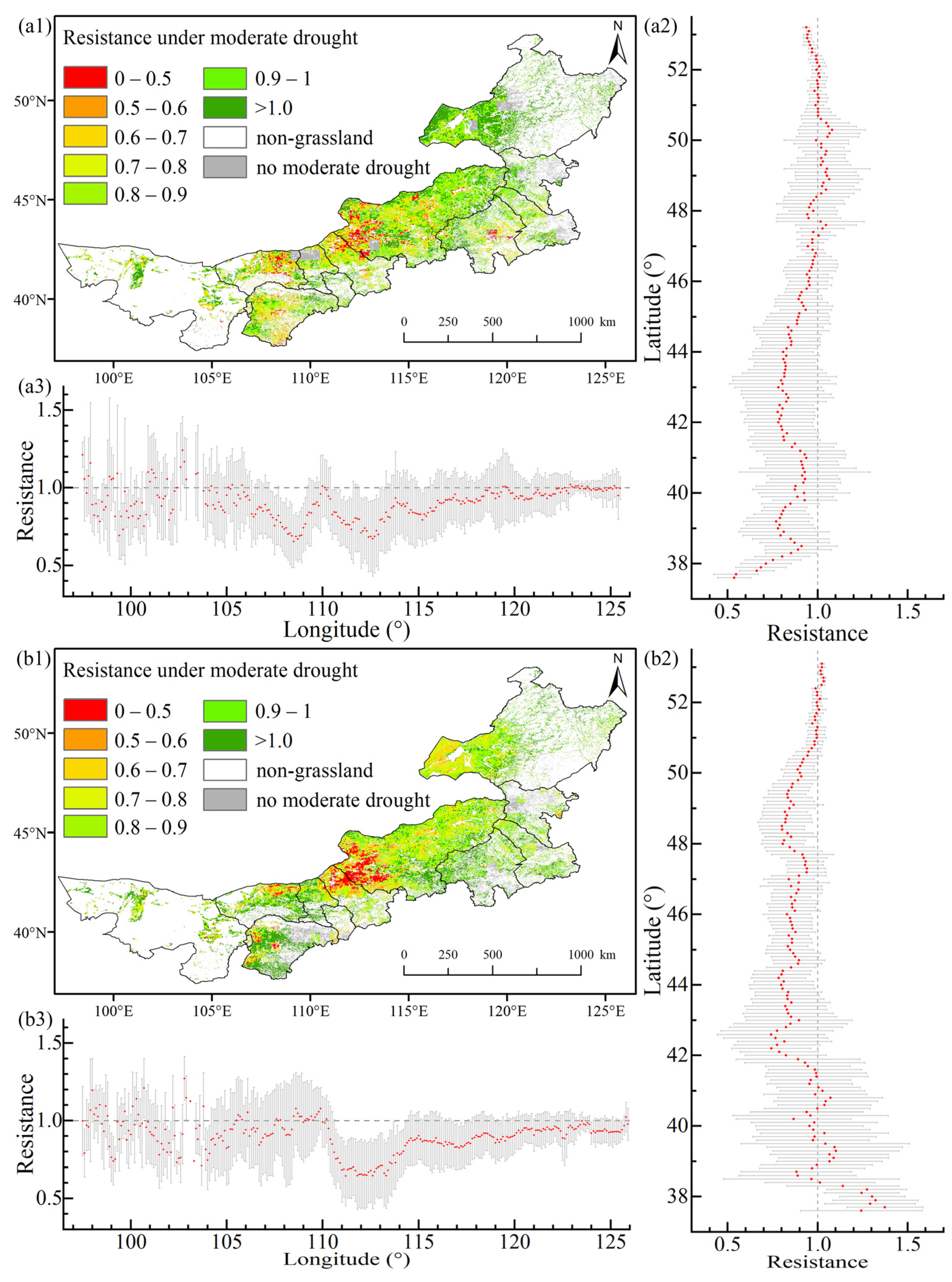
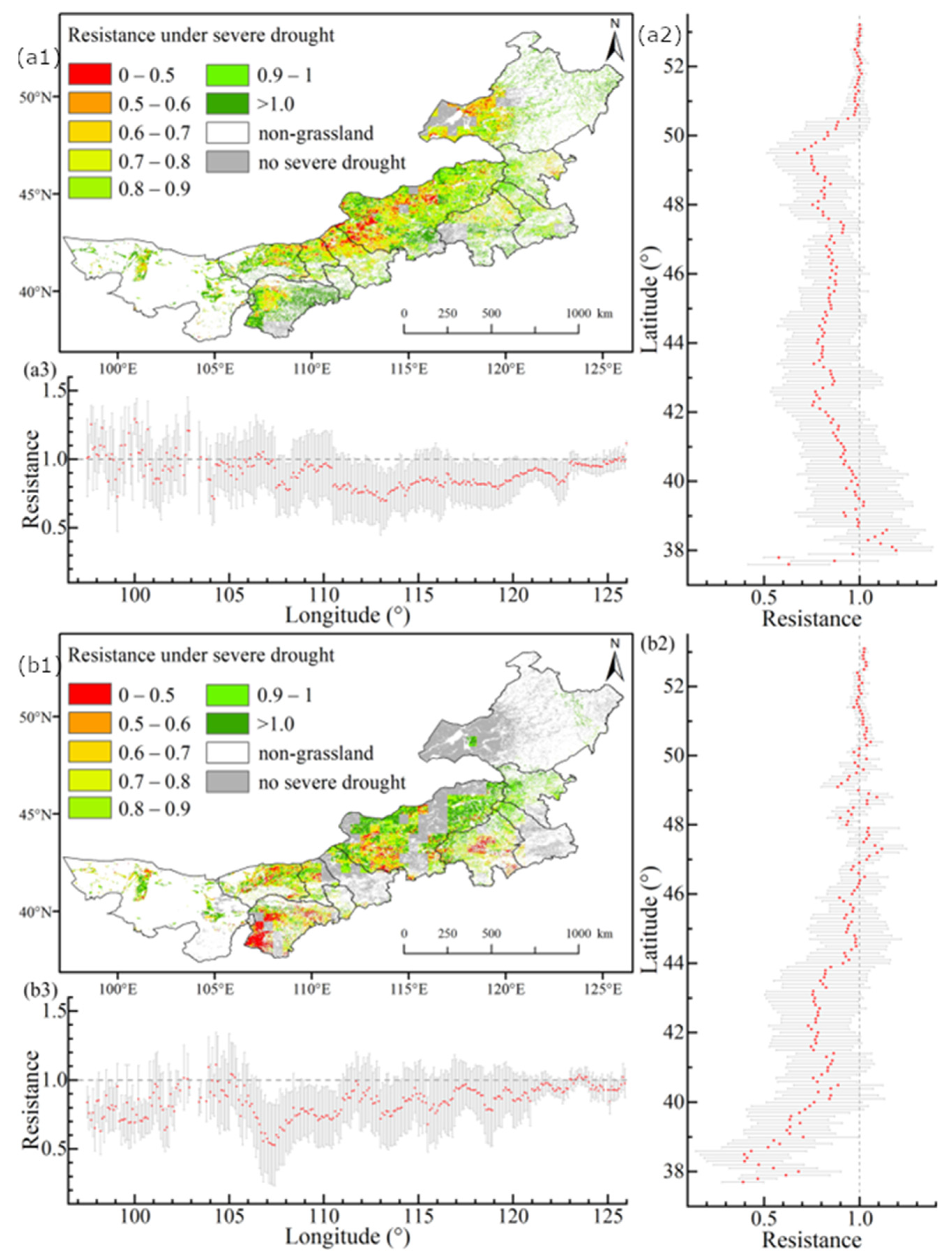
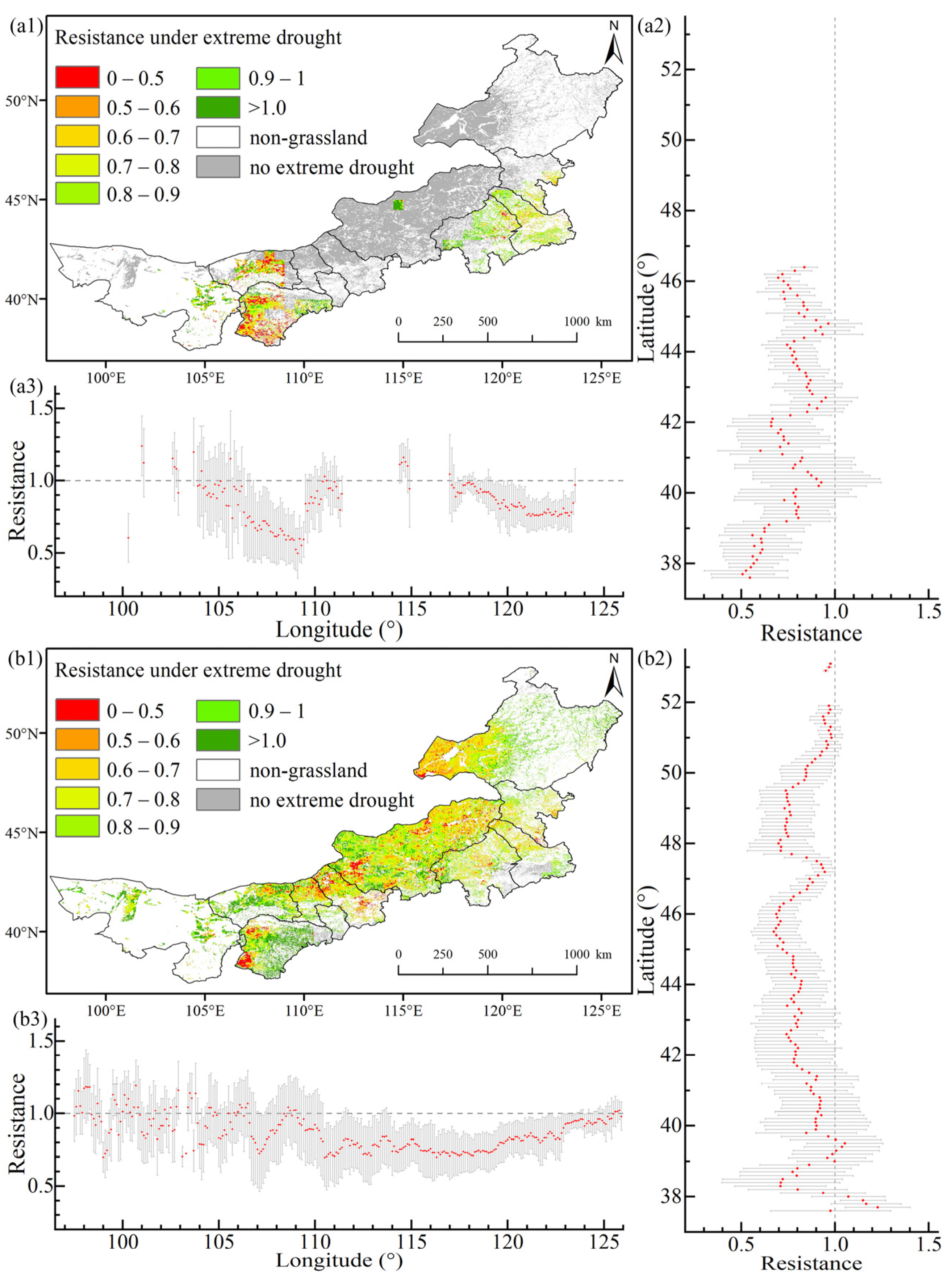
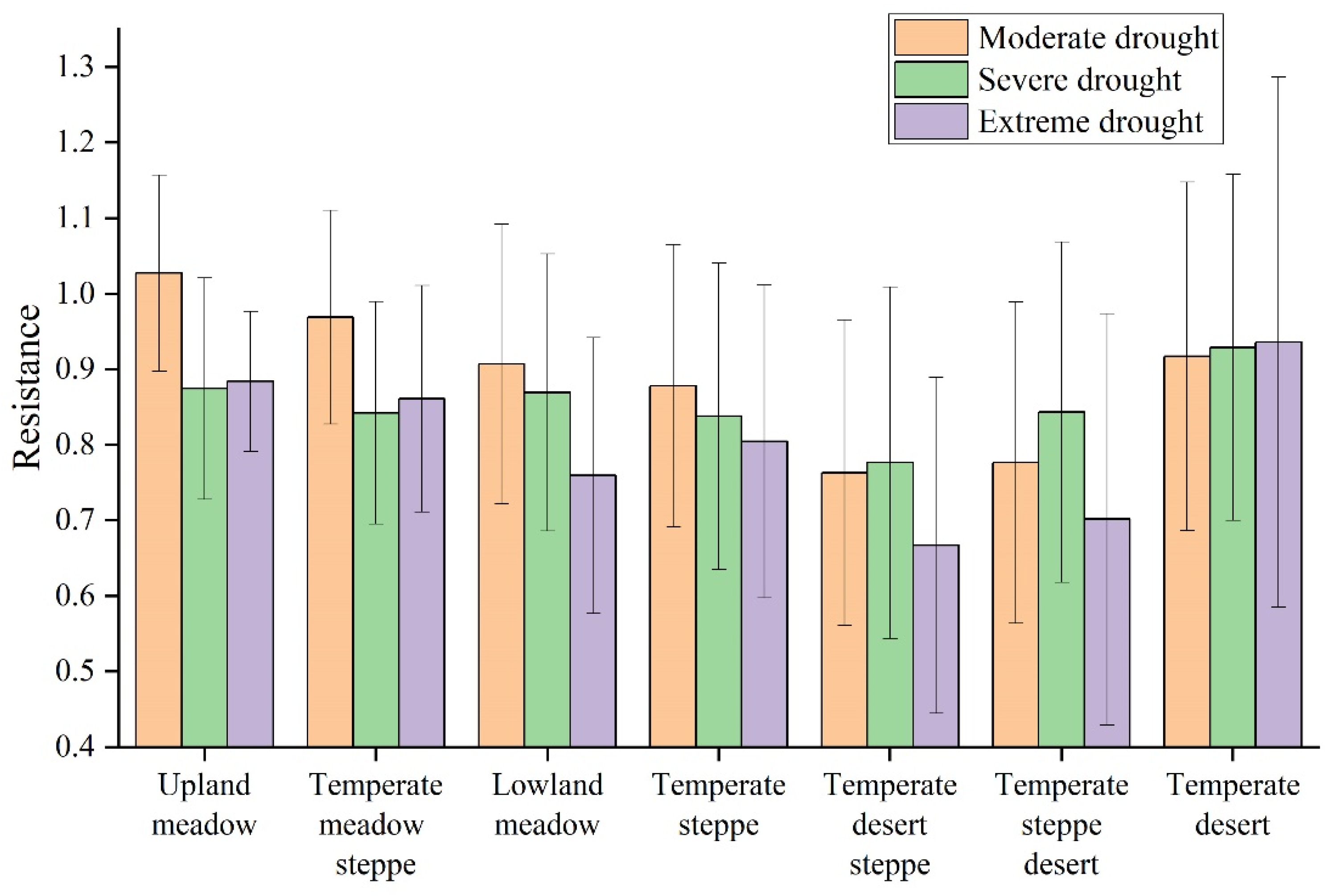
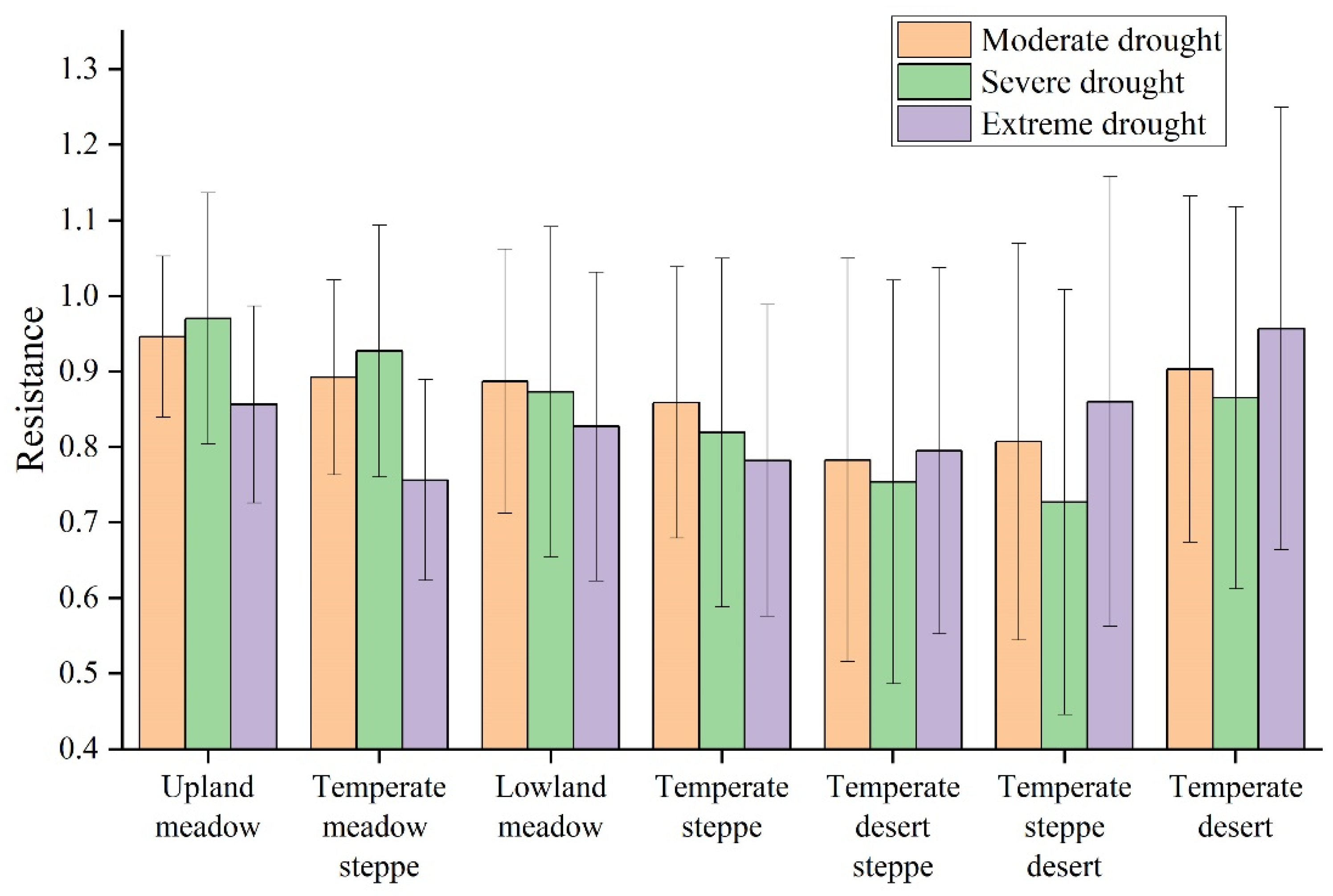
| Category | SPEI |
|---|---|
| Extreme drought | SPEI ≤ −2 |
| Severe drought | −2 < SPEI ≤ −1.5 |
| Moderate drought | −1.5 < SPEI ≤ −1 |
| Near normal | −1 < SPEI ≤ 1 |
Disclaimer/Publisher’s Note: The statements, opinions and data contained in all publications are solely those of the individual author(s) and contributor(s) and not of MDPI and/or the editor(s). MDPI and/or the editor(s) disclaim responsibility for any injury to people or property resulting from any ideas, methods, instructions or products referred to in the content. |
© 2023 by the authors. Licensee MDPI, Basel, Switzerland. This article is an open access article distributed under the terms and conditions of the Creative Commons Attribution (CC BY) license (https://creativecommons.org/licenses/by/4.0/).
Share and Cite
Guo, J.; Yang, X.; Jiang, W.; Xing, X.; Zhang, M.; Chen, A.; Yang, D.; Yang, M.; Wei, L.; Xu, B. Resistance of Grassland under Different Drought Types in the Inner Mongolia Autonomous Region of China. Remote Sens. 2023, 15, 5045. https://doi.org/10.3390/rs15205045
Guo J, Yang X, Jiang W, Xing X, Zhang M, Chen A, Yang D, Yang M, Wei L, Xu B. Resistance of Grassland under Different Drought Types in the Inner Mongolia Autonomous Region of China. Remote Sensing. 2023; 15(20):5045. https://doi.org/10.3390/rs15205045
Chicago/Turabian StyleGuo, Jian, Xiuchun Yang, Weiguo Jiang, Xiaoyu Xing, Min Zhang, Ang Chen, Dong Yang, Mingxin Yang, Lunda Wei, and Bin Xu. 2023. "Resistance of Grassland under Different Drought Types in the Inner Mongolia Autonomous Region of China" Remote Sensing 15, no. 20: 5045. https://doi.org/10.3390/rs15205045
APA StyleGuo, J., Yang, X., Jiang, W., Xing, X., Zhang, M., Chen, A., Yang, D., Yang, M., Wei, L., & Xu, B. (2023). Resistance of Grassland under Different Drought Types in the Inner Mongolia Autonomous Region of China. Remote Sensing, 15(20), 5045. https://doi.org/10.3390/rs15205045






